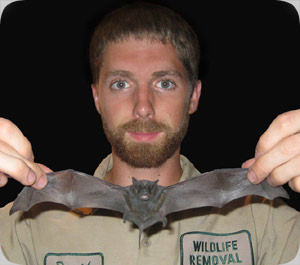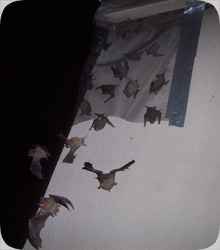
How To Get Rid of Bats
| You are visiting this site because you have bats in your Orlando home or building. You may have just discovered them - flying out of your home at dusk, leaving scattered droppings below. Or you may have known about a large population of bats in your building for some time, but now the situation is getting out of hand, with hundreds or thousands of bats, and a strong odor. Regardless, a colony of bats in a building is a serious matter. The colony will never leave, it will only grow in size, you don't like the sight or odor of the animals, and the droppings they leave behind can be hazardous to your health, not to mention the risk of rabies. We can help you. We are Florida's foremost experts on bat colony removal. We remove 100% of the bats, with a perfect success rate, we do not harm a single bat, we completely bat-proof your home or building, and we clean and decontaminate the mess that they leave behind. |  |
For an explanation of bat removal from attic prices, click here: bat control prices.
TIPS FOR GETTING RID OF BATS:
|
THESE THINGS WON'T WORK:
|
 | Superior Bat Exclusion: We have trained for years specially on bat control, in several states in the USA. We specialize in Florida bat control, and the two primary colonizing species of bats, the Brazilian Free-Tail Bat (Tadarida brasiliensis), and the Evening Bat (Nycticeius humeralis). Of the two, the Free-Tail bat is more common. Regardless, we are intimately familiar with the biology and behavior of all of Florida's bats. These two species in particular love to live in the attics or walls of homes and buildings. They form large groups, known as maternity colonies. These groups of bats never leave, and can grow to a very large size. Every summer, the female bats give birth to their baby bats, which are unable to fly for about eight weeks. When we come to your property, we inspect the building and study your bat problem often with a night watch. We remove all of the bats via specialty exclusion methods, such as seen in the photo to the left. Not a single bat is harmed during the process, and they are all evicted. |
How To Get Rid of Bats From An Attic
If you have bats in your attic, the only way to remove them is through the use of exclusion devices that will allow the bats to exit, but will not allow them to get back in. The exclusion devices are used at the bat entry point or points of your home. You first need to locate the entry points before you can put the exclusion devices on. If you miss an entry point, and the bats may have several, then they will get back in.
Determine Entry Points
The easiest way to determine the bat entry points is to watch for them to leave at night. The majority of the colony will fly out at one time, and you will be able to see where they are exiting. Observing their exit works best if you have several people helping you so that all areas of the home can be covered. Bats like high entry points that are safe from most predators, so look towards the roof of your home when waiting for their exit. Once youíve seen the general direction from which they are exiting, you can pinpoint your search.
One way to find the entry point is to observe your roof area at night when the bats fly out to feed. If you see them exit, you will at least have a starting point for your search. You will need a ladder to access the upper levels and roof of your home to look for the entry points. One sign of an entry point is piles of guano (droppings) stuck to a wall or piled in an area of the roof. Piles indicate entry points because it means that the bats are leaving droppings as they enter or exit the area. Piles donít always accumulate in just one spot as a result of bats flying and leaving droppings in random areas. You can also look for large amounts of urine stains on a wall or roof area. The same concept applies here; if the urine is concentrated largely in one area, it is most likely near the entry point.
Common Entry Points
If you donít find any clues, such as guano or urine, you will have to thoroughly search for potential entry points. Bats can enter through a gap or crack as small as 3/8 of an inch, so you need to check every crevice carefully. Common bat entry points include gaps between the chimney and roof, loose fascia boards, loose siding, louvers, and vents. Check the eaves of your home carefully as these are another common entry point. You should also examine any loose shingles, broken windowpanes, rotten wood, or any other damaged areas. There could be more than one entry point, so donít assume youíre finished after finding one loose board.
Time Your Exclusion
If it is a time of year when there is no chance of baby bats in the roost, then the exclusion devices can be placed on the entry points. However, if it is April through August, the exclusion process will have to wait. It is illegal to perform live bat exclusion during those months because the baby bats are still flightless. That means that while the adult bats will go out at night to feed, the babies are left behind. You canít seal the babies in or prevent the mothers from getting back in to feed them.
When the exclusion devices can be used, they will be installed on the entry points. Bat exclusion devices can be made from many different types of materials, and they can take different forms. PVC pipes are often used because the slick, smooth inside of the pipe gives the bats nothing to grip. Plastic or metal mesh netting is also used, as are cones or funnels from plastic or metal. All of the exclusion devices have one similarity; they are designed with a one-way flap or valve so that the bats can exit through the device, but they are shut out and unable to re-enter through it. The devices are placed on all of the entry points, and are left on for several days, as the bats may not all exit at once.
Sometimes the bats are apprehensive about exiting the device, and sometimes they will have difficulties getting out for various reasons. Make sure to leave the exclusion device up for some time so they get used to it. After a few days, you can ascertain that all of the bats are gone, and you can then permanently seal the entry points. Depending on where they are on your home, entry points can be sealed using caulk or sealant, nails, bolts, and netting for areas that canít be sealed airtight. Follow up by checking the attic to make sure they havenít returned and that there arenít any trapped in there.
To learn more about the bat removal process, read about removal of bats in the attic, or my analysis, with field testing, of whether or not bat repellent works. Or go back to the Orlando Florida bat removal home page.
All of the content and photos (even the background wallpaper) is by me, the owner of the Orlando Bat Control company. We are based in Orlando and service all of central Florida, and in fact the whole state of Florida, including Tampa and Miami. We operate in the towns of Winter Park, Lake Mary, Longwood, Deltona, Sanford, Conway, Doctor Phillips, Metro West, Kissimmee, and more. If you have any questions about a bat problem in Florida, give us a call, and we can schedule an appointment to inspect the problem and get it taken care of.
